Day 1 :
Keynote Forum
Bhanu P S Chauhan
William Paterson University, USA
Keynote: Tailor made recyclable pt-nanoparticle catalysts for creation of functionalized vinylsilan
Time : 09:30-10:00

Biography:
Bhanu P S Chauhan is a Professor and Chairperson of the Chemistry Department at William Paterson University. He rose through the ranks of Assistant and then Associate Professor at City University of New York at the College of Staten Island, (CSI) before moving to his present position. He served at CSI as a Co-director of Center for Engineered Polymeric Materials as well as a one of the Member of CUNY Institute for Macromolecular Assemblies. He has co-authored various world-wide patents and numerous peer reviewed publications and have delivered plenary, invited, and oral presentations at national and international meetings. He has also edited a book titled Hybrid Nanomaterials, published by Wiley. Currently, he serves as an Editorial Board and/or Editorial Advisory Board Member of seven peer reviewed journals including Applied Organometallic Chemistry and Silicon. He has also been an Advisory Board Member of American Chemical Society-New Jersey Polymer Topical Group.
Abstract:
In recent years, our laboratory has been investigating new and industrially relevant routes to creating heterogeneous platforms of selectively cross-linked polysiloxanes, in which the metal nanoparticles are nucleated in desired concentration and morphology. We have observed that such ensemble of immobilized nanoparticles can act as highly efficient, mild and recyclable catalysts for hydrolytic oxidation of organosilane, hydrosilylation of olefin and polyolefins. In these cases, the air-stable solid catalyst first forms a homogeneous/dispersed phase with the reactant molecules and separates out at the end of reaction. In this presentation, we will present a mild, predictable, facile and widely applicable Pt-based recyclable platinum nanoparticle catalyzed selective hydrosilylation of mono- and di-substituted alkynes is reported. A variety of hydrosilanes were selectively reacted with alkynes containing diverse functionality including–Me, -Ar, -ArMe, -Ar(OMe), -SiMe3, (CH2)4CN, -ArNH2, -CH2NEt2 and -COOH to furnish corresponding vinylsilanes in high yields. In situ characterization using UV-vis, electron microscopy and controlled poisoning experiments during the reaction has revealed the participation of Pt-nanoparticles as an active catalyst. Whereas, the regio and stereo selectivity of the present nanoparticles catalyst were not very different for the hydrosilylation of certain alkynes reported previously, significant improvement in terms of catalytic efficiency, ease of catalyst recovery and recyclability over other platinum-based catalysts were achieved using polysiloxane stabilized Pt-nanoparticle catalysis. Thus, this catalysis allows one to produce functionalized vinylsilanes in excellent yields with the added advantage of a significant cost improvement over homogeneous platinum complexes.
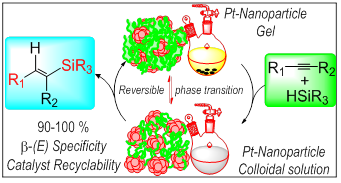
Keynote Forum
Hyun-Joon Ha
Hankuk University of Foreign Studies, South Korea
Keynote: Synthetic application of chiral aziridines
Time : 10:00-10:30

Biography:
Hyun-Joon Ha has obtained his BA from Seoul National University (1982) and PhD from Brown University (1987). He has done his Postdoctoral studies from Stanford University (1987-1988). Then he came back to Korea and worked as a Senior Research Scientist at KIST. In the year 1991, he joined the faculty of the Chemistry department at Hankuk University of Foreign Studies, and is now a Professor of the Chemistry department at the same University. His research includes aziridine chemistry, synthetic methodology, lipase-mediated reactions, asymmetric synthesis with publications of more than 140 papers and 25 patents. He serves as an Associate Editor of Asian J. Org. Chem.
Abstract:
Chiral aziridine-2-carboxylate possesses two important functional groups including carboxylate and aziridine ring which are useful for the synthetic purposes. Since both of (2R)- and (2S)-aziridine-2-carboxylates with phenylethyl group at the ring nitrogen were commercialized in optically pure forms, we have studied to extend their synthetic utilities for the construction of various nitrogen containing molecules in optically pure forms. The chemistry we have developed was based on aziridines focusing on two directions, namely the functional group transformation of carboxylate and the aziridine ring opening or expansions. The C-2 ester group can be transformed to aldehyde, alcohol, amide, ketones, ketoesters and amines bearing diverse substituents with proper stereochemistry in high yields. To carry out the ring-opening or ring-transformation of this aziridine should be activated as aziridinium ion or its equivalent with an assistance of proper electrophiles. The radiochemical pathway with substituents at C2 of this non-activated aziridine was disclosed to be dependent to the characteristics of substituent, electrophile and nucleophile. The aziridine ring opening reaction with properly functionalized side chain at the aziridine ring by various nucleophiles provided an easy access to diverse nitrogen-containing cyclic and acyclic molecules in asymmetric manner. The highlight of this chemistry was exemplified by an efficient and highly stereoselective synthesis of many biologically important molecules.
Figure 1.

Figure 2.

Keynote Forum
Hiroshi Nakazawa
Osaka City University, Japan
Keynote: Catalytic hydrogenation of non-polar unsaturated organic molecules promoted by bifunctional iron complexes
Time : 10:30-11:00

Biography:
Hiroshi Nakazawa has completed his PhD in 1981 from Hiroshima University, Japan. After working at Tokyo Institute of Technology and at University of Utah as a Post-doctoral Research Fellow, he became a Research Associate at Hiroshima University in 1984, and was promoted to an Associate Professor. From 1994 to 1996 he was appointed an Associate Professor of Institute for Molecular Science. Since 2002, he has been a Full Professor of Osaka City University. He received the Commendation for Science and Technology from the Ministry of Education of Japan in 2009, the Award for Chemical Education from the Chemical Society of Japan in 2015, and Japan Society of Coordination Chemistry Award in 2016.
Abstract:
The hydrogenation reaction of unsaturated bonds promoted by a transition metal catalyst is one of the most fundamental transformations in organic synthesis. Using a metal-ligand bifunctional catalyst of transition metals is one of the attractive approaches. Shvo complex is the first example of a metal-ligand bifunctional catalyst that has Ru-H and O-H functional groups. The complex showed effective hydrogenation activity for organic molecules with a polar unsaturated bond such as ketone or aldehyde, but did not show activity for those with a non-polar unsaturated bond such as alkene or alkyne. This report shows preparation and isolation of new hydride iron complexes bearing a Si-H or a Ge-H bond tethered to the Cp derivative ligand and their hydrogen transfer activity towards unsaturated organic compounds. Iron hydride complexes bearing a Si-H or a Ge-H functional group in a ligand, [2,5-SiPh3-3,4-butylene-(h5-C4COEEt2H)]Fe(CO)2H (E = Si: 1, Ge: 2) and [2,5-SiPh3-3,4-butylene-(h5-C4COSiMe2OSiMe2H)]-Fe(CO)2H(3), were synthesized in the reaction of iron acetonitrile complex, [2,5-SiPh3-3,4-butylene-(h4-C4CO)]Fe(CO)2(NCCH3), with Et2EH2 or HSiMe2OSiMe2H. Conventional bifunctional complexes which possess O-H on the ligand and M-H bonds have been reported to react predominantly with ketone or aldehyde rather than with alkyne or alkene. In stark contrast, 1 did not react with methyl phenyl ketone, but 1 reacted with p-tolylacetylene to give the corresponding alkene and alkane (Scheme 1). The reactivity of 1 is considered to be attributable to the polarity of the Si-H bond being opposite to that of an O-H or N-H bond. This is the first example of iron promoting transfer hydrogenation reaction from alcohol to alkyne or alkene in one pot. Such catalytic transfer hydrogenation reactions have been reported for Ru, Rh, Ir, and Pd, and most of them require addition of base such as K2CO3, Na2CO3, and KOH.

Scheme 1: Reactivity of bifunctional iron complexes
- Sessions/ Tracks:
Advanced Synthesis and Catalysis | Bioorganic and Biochemistry | Organometallic Chemistry | Advance Trends in Organic Chemistry | Natural Products and Heterocyclic Chemistry | Modern Organic Chemistry and Applications | Medicinal Chemistry, Drug Synthesis | Inorganic Materials and Nanoparticles | Green Chemistry and Sustainable Technology | Polymer Chemistry

Chair
Yingju Xu
Merck & Co.

Co-Chair
Hyun-Joon Ha
Hankuk University of Foreign Studies, Korea
Session Introduction
Yuichi Shimazaki
Ibaraki University, Japan
Title: Mechanistic study of alcohol oxidation by oxidized CuII salen-type complexes: Relationship between reactivity and the electronic structure of the complexes
Time : 11:15-11:40

Biography:
Yuichi Shimazaki received his Doctor’s degree in Science from Nagoya University in 2000 under the supervision of Professor Osamu Yamauchi. He joined Professor Yoshinori Naruta’s group at Kyushu University as Assistant Professor and worked on the redox behavior of various metal porphyrin complexes as models of the active site of metalloenzymes. In 2008, he was promoted to Associate Professor at the College of Science, Ibaraki University. His research interests include the oxidation chemistry of the complexes of various metal ions, model studies of metalloenzymes, bioorganometallic chemistry and weak interactions in metal-organic molecule systems.
Abstract:
The redox chemistry of metal complexes has been widely developed in recent years, affording deep insights into the reaction mechanisms for many useful homogeneous catalytic reactions and enzymatic reactions at the active site of metalloenzymes. While studies on oxidative reaction intermediates are in progress, the oxidation state of the metal ions in the active species has not been fully understood until now. Detailed descriptions of the oxidation state of the intermediate are sometimes complicated, because the oxidation locus on oxidized metal complexes is often different from the “formal” oxidation site. Although “formal” and “experimental” oxidation numbers are identical in many cases, they are frequently used as synonyms, since the term of the physical or experimental oxidation state has not been accepted in some areas of chemistry. This practice leads to considerable confusion and presents an obstacle to the progress of the experimental determination of the intermediate. Tetradentate Schiff-bases, such as salens, have received considerable attention as a ligand system due to their relative ease of synthesis, ability to form stable complexes with many metals in a variety of oxidation states, and versatility as catalysts for important organic transformations. Concurrent studies have investigated the electronic structure of oxidized metal salen systems, determining the factors that control the locus of oxidation in these complexes. Depending on the relative energies of the redox-active orbitals, metal complexes with pro-radical ligands can exist in a limiting description as a metal-ligand radical, [Mn+(L·)]n+, or a high valent metal complex, [M(n+1)+(L-)]n+. This presentation would discuss with recent advances in the chemistry related with the oxidation behavior of some metal–salen type complexes and their properties, especially focusing on comparison of their properties with those of the high valent metal–phenolate complexes which are iso-electronic with the phenoxyl radical complexes.
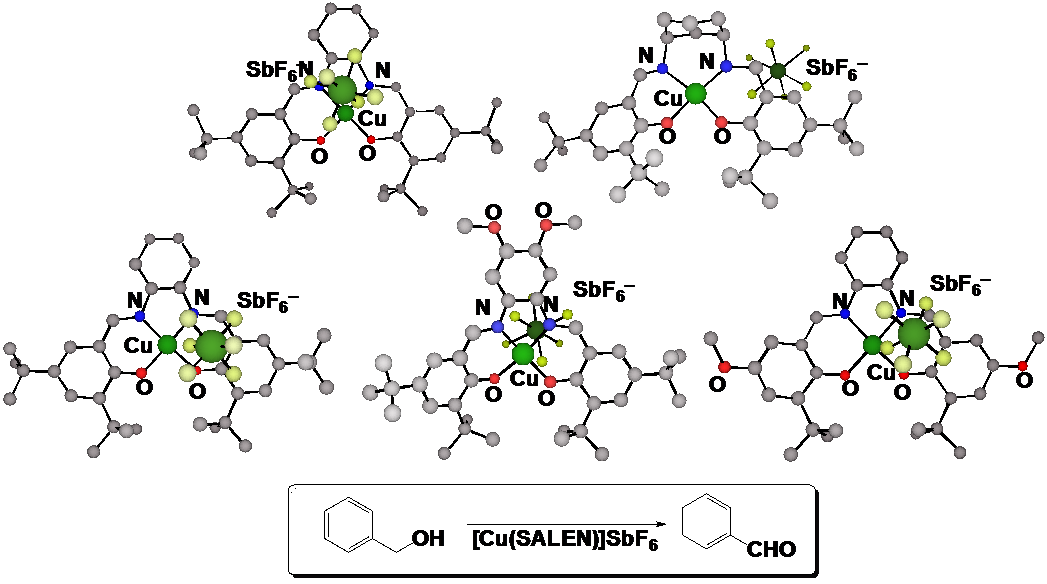
Figure 1: Crystal structures of one-electron oxidized Cu(II)-salen type complexes and the oxidation of benzyl alcohol by their oxidized complexes.
Ashoka Samuelson
Indian Institute of Science, India
Title: Electronic requirements for C-H activation in half-sandwich complexes
Time : 11:40-12:05

Biography:
Ashoka G Samuelson had his early education in Tiruchirapalli, India. After obtaining a Master’s degree in Chemistry from the Indian Institute of Technology, Madras at Chennai he finished his Doctoral studies at Cornell University, Ithaca. He has been working in the Department of Inorganic and Physical Chemistry at the Indian Institute of Science, Bangalore since then. His research interests are organometallic and coordination chemistry of transition metals. Their goal is to utilize the reactivity of organometallic compounds to devise new catalysts or anticancer active molecules. His research group often employs computational tools to supplement and complement their experimental findings.
Abstract:
Activation of C-H bonds continues to attract significant attention. The interaction of C-H bonds plays an important role in several reactions besides being the key step for activating alkanes. We have carried out computational study of the interaction half-sandwich metal fragments (metal=Re/W/Ru, electron count=d6/d8), containing linear nitrosyl (NO+), carbon monoxide (CO), trifluorophosphine (PF3), N-heterocyclic carbene (NHC) ligands with alkanes using density functional theory employing the hybrid meta-GGA functional (M06). With d6 metal complexes, electron deficiency on the metal improves the formation of stable alkane complexes in the order NHC

Ling He
Xi’an Jiaotong University, China
Title: Hydrophobic, hydrophilic and amphiphilic silica/copolymer nanoparticles by surface-initiated atom transfer radical polymerization
Time : 12:05-12:30

Biography:
Ling He is a Professor and Director of Chemistry Department, Xian Jiaotong University. She got her PhD in Material Chemistry and MSc in Analytical Chemistry in China. She has worked as Visiting Scholar in University of Munich University (Germany) and University of Bologna (Italy). The main research fields are focused on copolymers and their self-assembly micro/nano hierarchical properties for coating materials, and the characterization of polychromy and analysis of natural polymeric compounds by nondestructive and in-situ detecting techniques. The main research activities includes hosting the National Key Basic Research and Development Program (973 program), Natural Science Foundation of China (NSFC) program; Key Project in the National Science and Technology Pillar Program of China. During the last five years, she has published about 80 articles in peer reviewed journals, published 5 books and made many presentations as well as invited plenary lectures in international meetings and conferences.
Abstract:
Silica/diblock copolymer nanoparticles (SDCNs) are synthesized by surface-initiated atom transfer radical polymerization (SI-ATRP) for hydrophobic, hydrophilic and amphiphilic materials, their properties as protein-resistance coatings are investigated. The hydrophobic SDCNs of SiO2-g-PMMA-b-P12FMA is synthesized by methyl methacrylate (MMA) and dodecafluoroheptyl methacrylate (12FMA) using silica surface initiator (SiO2-initiator with a density of 0.573 mmol·g-1). The three mass rations of hydrophobic SDCNs are proved as 25–30 nm core–shell particles in CHCl3 solution composed of P12FMA core and PMMA shell, but densely twined together as agglomerated particles. The increasing P12FMA content could obviously increase the surface roughness of the film (50-500 nm) and thereby contributes to the hydrophobic (112-118º) and oleophobic (45-78º) properties with lower water absorption and viscoelasticity, but a high thermo stability at 420-450℃. The amphiphilic SDCNs of SiO2-g-P(PEGMA)-b-P(12FMA) is prepared by poly (ethylene glycol) methyl ether methacrylate (PEGMA) and P12FMA. Their amphiphilic behavior, lower critical solution temperature (LCST), and surface properties as protein-resistance coatings are characterized. The individual spherical nanoparticles (150 nm -170 nm) as P(PEGMA)-b-P(12FMA) shell grafted on SiO2 core (130 nm) to gain obvious low LCST at 36-52℃ and high thermo stability at 290-320℃. The water-casted SiO2-g-P(PEGMA)-b-P(12FMA) films obtained much rougher surface (125.3–178.4 nm) than THF-casted films (11.5–16.9 nm). Therefore, the water-casted surfaces exhibit obvious high water adsorption amount and hard adsorbed layer, but present loser adsorbed layer than THF-casted films. While, the introduction of P (12FMA) segments does not show obviously reduce in the protein-repelling adsorption of SiO2-g-P(PEGMA)-b-P(12FMA) films. The hydrophilic SDCNs of SiO2-g-P(PEGMA)-b-P(PEG) is prepared by PEGMA and poly(ethylene glycol) methacrylate (PEG). Their temperature sensitive behavior, pH response and surface properties as protein-resistance coatings are characterized. 220 nm core-shell nanoparticles are formed in water solution, which gained LCST at 60-77ËšC and good dispersion in water when pH>5.0. The introduction of P(PEG) segments could increase the protein-repelling adsorption of SiO2-g-P(PEGMA)-b-P(PEG) films. Therefore, these SDCNs are suggested to be used as protein resistance coatings.

Figure.1: Synthesis of hydrophobic SiO2-g-PMMA-b-P12FMA and the aggregation of amphiphilic SiO2-g-P (PEGMA)-b-P (12FMA)
XIE Linghai
Nanjing University of Posts and Telecommunications, China
Title: The discovery of one-pot protocol to synthesize spiro[n]arenes
Time : 12:30-12:55

Biography:
XIE Linghai is a Professor of organic/polymer materials chemistry at Nanjing University of Posts and Telecommunications (NUPT). He obtained his PhD from Fudan University in June 2006. After this, he joined Nanjing University of Posts and Telecommunications (NUPT) and become a Leader of the Center for Molecular Systems and Organic Devices (CMSOD@IAM). He won the NSFC award for Excellent Young Scholar in 2013. His research activities focus on molecular installing technology (MIT), synergistically molecular attractor-repulsor theory (SMART), polygrid based nanopolymer wide-bandgap semiconductors, organic electrets for memories and memristors. He has published more than 150 papers in reputed journals and has been cited by more than 2000.
Abstract:
Four-element theory of matter-energy-information-consciousness (MEIC) guide human being to enter the era of consciousness (EOC) that will make service abundant extremely, resulting in the achievement of socialism and communism. Toward EOC, the surface-equal-device engineering is necessary to make the matter or objects smart that require the universe semiconductor materials. In order to make optoelectronic materials available easier, we always focus on the carbon-based organics for the investigation on the cycle of molecular systems and organic devices by means of the feature of diversity, flexibility and multiscale hierarchy. In the past decade, we discovered and established a facile one-pot protocol to synthesize the spiro[n]arenes and spirofluorenes with an orthogonal and cross-shaped configuration. The high-yield cascade tandem reaction makes spirofluorene xanthene (SFX) with low-cost, pot-atom-step economic (PASE) procedure. SFX-based chemistry has been conducted with various C-C or C-X coupling reaction to establish a diverse platform of bulky semiconductors for organic light-emitting diodes (OLEDs), transistor memory and perovskite solar cells, etc. Non-doped deep-blue SFX-based semiconductor was successfully prepared and adopted in OLEDs with external quantum efficiency (EQE) of 4.1%. Simultaneously, SFX-based host (SFXSPO) with a promising EQE of 22.5% was achieved in the corresponding thermally activated delayed fluorescence dives. Additionally, we have prepared SFX-based semiconductor (TTMeODPA-SFX) as hole-transporting material for perovskite solar cells (PSCs) and achieved improved power conversion efficiency of 12.94% and open-circuit photo-voltage of 1.00 V.
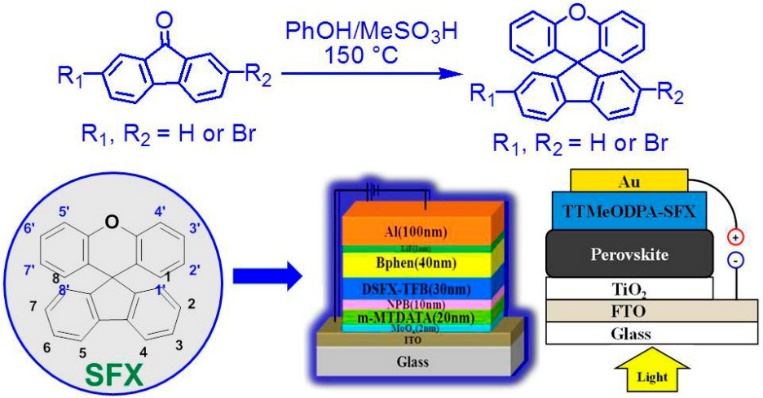
Fig.1: One-pot procedure of SFX-based semiconductors for OLEDs and solar cells.
Masao Takagaki
Kyoto University, Japan
Title: Concept of malignancy of brain tumors for drug design of boron neutron capture therapy
Time : 13:45-14:10

Biography:
Masao Takagaki has studied many subjects like Physics, Medicine, and Anthropology in Kyoto University. Currently, she is a Japanese Neurosurgeon who is investing Boron Neutron Capture Therapy for malignant brain tumors for more than 40 years. She has invested new boron/Gd compounds co-operating with many American Researchers.
Abstract:
Boron Neutron Capture Therapy (BNCT) is a radiotherapy which combines biological targeting and high LET radiation. This type of therapy consists of the enrichment of tumors with 10B, and the successive irradiation of the target with low energy neutrons. This produces heavy ionizing particles that cause non-repairable damage to the cells. If 10B accumulates selectively in the tumor cells, high linear energy transfer (LET) radiation and tumor-selective radiation will not cause serious damage to the surrounding normal tissues. Previous phase-I studies shows that BNCT might be effective and safe in patients with inoperable, locally-advanced malignant glioma and head and neck cancers, even those that recur at previously irradiated sites. However, despite extensive efforts for over half century, it is difficult to ensure that the selective targeting of 10B will be successful. One can argue whether Locher's BNCT theory published in 1936 is feasible? We talk about the uncertainty and selectivity of boron targeting for malignant brain tumors (gliomas) and we presented about biological aspects for understanding of malignancy and intracranial tumor cells infiltration for organic and inorganic boron chemistry for BNCT targeting. From the viewpoint of boron chemistry, the conditions required for boron targeting are: (1) a low toxicity, (2) the ability to be held in a tumor and/or tumor cells selectively for a certain period of time, (3) to be rapidly excreted from the body system. These points are essential, but to achieve each of these at the same time is a very difficult task. Furthermore, we shortly discuss about the potential future problems of BNCT by reviewing an extensive number of recently published articles and author’s works regarding boron targeting for BNCT.

Yingju Xu
Merck & Co., Inc, USA
Title: Process development towards a green manufacturing route for letermovir exploiting novel asymmetric reactions
Time : 14:10-14:35

Biography:
Yingju Xu has attended Nanjing University, China, receiving her BA and MS in Organic Chemistry. She then conducted Graduate Research in the laboratory of Professor Soctt J Miller at Boston College, MA, earning her PhD in 2007. She joined the Department of Process Chemistry at Merck in 2007. She has 10 years of process development experience on various drug candidates. Her research experience at Merck focuses on discovery of innovative approaches to access drug candidate via low-cost and sustainable processes, design and development of robust green manufacturing processes for target drug candidates, as well as late stage process development to support filing and commercialization.
Abstract:
Merck aims to develop the best chemistry at time of regulatory filing, with the ultimate goal of the zero waste API manufacturing process. Achieving this ambitious goal is enabled by an innovative, green by design, development strategy, to progress from initial route design through to a fully optimized sustainable commercial manufacturing process. Letermovir is an antiviral drug currently in late-stage development for the treatment of cytomegalovirus infections. This presentation will describe key aspects of the synthesis development that led to an efficient, robust and green manufacturing process. A chemically stable and fully recyclable organo catalyst has been discovered to promote this novel asymmetric aza-Michael cyclization. The remainder of the synthesis has been fully optimized to reduce catalyst loading, minimize the number and amount of solvents, employ telescoped processing where possible, and to maximize atom-economy. Implementation, demonstration and validation of the new process were successfully completed in 2016. Compared to the benchmark process used for the generation of the initial phase III clinical supplies, this revolutionary new synthesis reduces PMI by 73%, increases the overall yield by more than 60%, and reduces raw material costs by 93%. Life-cycle assessment reveals that the new process reduces carbon footprint and water usage by 89% and 90%, respectively.

Nawarat Worauaychai
Ramkhamhaeng University, Thailand
Title: Corrosion behavior of TiC-Ni-5Mo2C cermet
Time : 14:35-15:00

Biography:
Nawarat Worauaychai has completed her PhD from Division of Materials Technology, School of Energy, Environment, and Materials, King Mongkut’s University of Technology Thonburi, Thailand. She is a lecturer at Department of Materials Technology, Ramkhamhaeng University. She has her expertise in powder metallurgy and corrosion study of alloys and composite materials. Most of her research ideas are mainly synthesize of new alloys and evaluation of mechanical properties and corrosion behavior.
Abstract:
Corrosion in TiC-Ni-5Mo2C cermet was studied in 0.3M H2SO4, 1M NaCl and 1M NaOH by means of anodic polarization method. Corrosion morphologies were then examined by SEM-EDS. The results showed that there are two ranges of passive region in acidic condition; whereas only one passive region was observed in alkaline solution. In case of chloride containing solution, passive region was hardly observed. The SEM micrographs revealed that nickel binder was a corrosion onset site in acidic and salt solution. In contrast to alkaline condition, the deterioration commenced at TiC. The driving force for corrosion susceptibility was the micro-galvanic cell formation between TiC and Nickel.

Figure 1: Potentiodynamic polarization curves of TiC-Ni-5Mo2C cermet in (a) 0.3M H2SO4 (b) 1M NaCl (c) 1M NaOH solution
Makanjuola Olatunji Mojeed
Federal University of Agriculture, Nigeria
Title: Effect of agrochemicals on metal speciation and their associated health risk in soil and vegetable species
Time : 15:00-15:25

Biography:
Abstract:
There is increasing global concern over the adverse effects of inorganic fertilizer and pesticides application on agricultural soils. Therefore, this study investigated the effect of agrochemical treatment on metal speciation and associated health risks in soil and vegetables species. 24 soil samples and nine varieties of vegetable species were collected from farm settlement in Ikorodu, Lagos, Nigeria and sequentially extracted using standard method. Extracts were analyzed for heavy metals using atomic absorption spectrophotometer, while health risk was assessed using United States Environmental Protection Agency (USEPA). The result reveals the redistribution pattern of heavy metals among the soil mineral components after chemical treatment. A comparison of metal concentrations in soil and vegetable species with standard set by USEPA shows that Cd level in the soil (13.54±1.21 mg/kg) and vegetables (0.83±0.05mg/kg) were above the critical permissible limit of 3.0mg/kg and 0.2mg/kg respectively. Based on soil pollution indices used for this study, it was deduced that the soil was practically not contaminated with all metals investigated in the soil except Cd which have very high contamination factor (CF), contamination degree (CD), pollution load index (PLI) and geo-accumulation index (Igeo). The cancer risk of heavy metals in the soil ranged from 1.02E−11 to 9.90E−10 and 6.70E−11 to 8.61E−09 for children and adult while that of vegetable species ranges from 6.03E−11 to 10.8E−10 and 3.70E−11 to 6.61E−09 for children and adult respectively. The level of cancer risk falls below the threshold values (10−4–10−6) which US Environmental Protection Agency considered as unacceptable risk.
Hyun-Joon Ha
Hankuk University of Foreign Studies, Korea
Title: Polyhydroxy alkaloids from aziridine
Time : 15:25-15:50

Biography:
Hyun-Joon Ha has obtained his BA from Seoul National University and PhD from Brown University. He has done his Postdoctoral studies from Stanford University (1987-1988). Then he came back to Korea and worked as a Senior Research Scientist at KIST. In the year 1991, he joined the faculty of the Chemistry department at Hankuk University of Foreign Studies, and is now a Professor of the Chemistry department at the same University. His research includes aziridine chemistry, synthetic methodology, lipase-mediated reactions, asymmetric synthesis with publications of more than 140 papers and 25 patents. He serves as an Associate Editor of Asian J. Org. Chem.
Abstract:
Alkaloids are nitrogen-containing natural products found in diverse organisms including fungi, plants, and animals. Among them, polyhydroxy alkaloids have a plethora of intriguing biological activities. Owing to their importance within the realm of medicinal and bioorganic chemistry, there is a rich literature detailing the attempts towards the synthesis of natural polyhydroxy alkaloids and their analogs. In most cases, those were prepared from uniquely functionalized starting materials with the assistance of a series of chemical transformations involving the construction of the carbon backbones followed by the stereoselective installation of hydroxyl groups. These synthetic strategies do not allow preparing multiple synthetic targets from a common synthetic intermediate. A chiral aziridine-2-carboxylate is a good starting material to elaborate polyhydroxy alkaloids, many of which were prepared in our laboratory in highly efficient manner with structural diversities. One of the typical examples is 1-deoxynojirimycin derived from hydroxyl functionalities using the common advanced synthetic intermediate via different hydroxylation methods. In additional polyhydroxy pyrrolidine alkaloids were also synthesized by branching two possible regiochemical pathways of ring-opening reactions of 2-substituted aziridine as a common synthetic intermediate providing an easy access to two different classes of compounds. Efficient regiochemistry-directed syntheses of monocyclic, bicyclic, and acyclic polyhydroxy alkaloids were achieved by taking different regiochemical pathways of aziridine ring-opening reactions of dihydroxylated aziridine as a common synthetic intermediate, which was readily available from commercial aziridine-2-carboxylate. Two possible regiochemical pathways of aziridine ring opening provided an easy access to two different classes of compounds from a common synthetic intermediate, called as regioselectivity-directed branches of 2-substituted aziridine. The applications of this synthetic strategy diversifing the stereoselective dihydroxylation and regioselective aziridine-ring opening as the key steps allowed the asymmetric synthesis of natural and unnatural polyhydroxy alkaloids including calyculin fragment C33-C37, 1,4-dideoxy-1,4-imino-L-ribitol and analogs of hyacinthacine, swainsonine, castanospermine and deoxynojirimycin.

Thomas E Müller
RWTH Aachen University, Germany
Title: Catalysis and life-cycle-analysis of current and future industrial routes to CO2 utilization
Time : 16:05-16:30

Biography:
Thomas E Müller is Lecturer at RWTH Aachen University, Germany. He has received a PhD in Chemistry (1995) from Imperial College London. After positions at University of Sussex and TU Munich and Visiting Professor position at NUS Singapore (2005) and University of Tokyo (2005), he accepted a position at Covestro in 2007. Since 2015 he has been concentrating on taking innovation to the chemical industry. He is Associate Editor of JCOU. His achievements include 80 papers and 75 patent applications, mainly in the fields of CO2 chemistry, catalyst development, and materials. His vision is to bridge the gap between fundamental research and industrial application.
Abstract:
The utilization of carbon dioxide (CO2) as an inexpensive and renewable C1 feedstock is of strategic importance for decreasing our dependence on fossil based raw materials (Ref. 1). In this context, the direct build-up of fuels, chemicals and polymers, at least partially, from CO2 is of particular interest. Various technologies are being discussed for implementation in the industry (Figure 1). The lecture will compare the current status of these technologies, the changes effected upon introducing CO2 as feedstock and evaluate the CO2 reduction potential based on the currently available life-cycle-analyses. One recently commercialized process that involves the direct use of carbon dioxide as a feedstock is the production of organic carbonates by reaction of CO2 with epoxides (Ref. 2-4). Indirect routes for CO2 utilization are of equal relevance. Formaldehyde, commercially attained by partial combustion of methanol that, in a future economy, may be obtained from CO2, is a promising feedstock. Thus, oligomeric poly (acetalester) is generated readily from formaldehyde. Such poly (acetalester) has intriguing properties rendering them inspiring compounds for fuel and polymer applications. Motivated by the goal of expanding the CO2 technologies to further application fields, it seems essential to unravel highly effective strategies for activating the carbon dioxide molecule. The energy needed to overcome the thermodynamically low energy level of CO2 is thereby a crucial factor. Only when the energy level of the resulting intermediates is appropriate, the subsequent reaction of the activated CO2 molecule with the co-reagents will take place. The right choice of the catalyst is thus the key to CO2 conversion and directs the reaction pathway to the desired target products. The lecture concludes with discussing some of the most intriguing approaches for activating CO2.
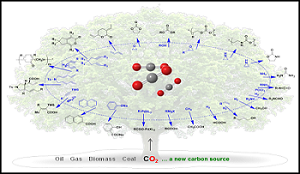
Figure.1: The utilization of carbon dioxide (CO2) as an inexpensive, renewable and abundant C1 feedstock is of strategic importance for decreasing our dependence on petroleum-derived raw materials.
Marco Giulio Rigamonti
Politecnico di Milano, Italy
Title: Stereoselective synthesis of hernandulcin, peroxylippidulcine A, lippidulcines A, B and C and taste evaluation
Time : 16:30-16:55

Biography:
Marco Giulio Rigamonti studied chemical engineering at Polytechnique of Milan and graduated with top of marks under the supervision of prof. F. Gatti in 2014. Currently he is pursuing a PhD in Polytechnique de Montreal with prof. G. Patience, working on spray drying, computational analysis and scale up for Li-ion battery manufacturing and catalyst for fluidized bed reactors.
Abstract:
Sucrose abuse is strongly associated to many undesirable health effects. Artificial sweeteners are a popular alternative but many raise questions regarding their safety. The Mexican plant Lippia dulcis contains trace amounts of (+)-hernandulcin, a compound so sweet – 1000 times more that sucrose–that few leaves are enough to sweeten a cup of tea. Recent studies revealed that the plant also produces several derivatives of this molecule: The peroxylippidulcines and the lippidulcines A, B and C. However, these sesquiterpenes have been isolated in such a small amount that it has not been possible to assess their taste. A multigram scale-up and optimization for the synthetic route of (+)-hernandulcin, allowed us to accomplish the first stereoselective synthesis of lippidulcines A, B and C. With modified version of the Kornblum–DeLaMare rearrangement, and a highly regioselective and stereoselective ketone reduction with the MeCBS reagent we synthesized the compounds and confirmed the previously assigned absolute configuration. The taste evaluations indicate that lippidulcine A is a cooling agent with a mint after taste, while none of these sesquiterpenes are sweet. Indeed, the insertion of a hydroxy group on the side chain of hernadulcin annuls its intense sweetness.

Ziwei Gao
Shaanxi Normal University, China
Title: Multi-functional N, O donors for Cu catalyzed Csp2-Csp cross-coupling reaction
Time : 16:55-17:20

Biography:
Abstract:
The Sonogashira reaction is one of the most important and widely used Csp2–Csp bond formation reactions in organic synthesis, frequently employed in the synthesis of natural products, biologically active molecules, heterocycles and molecular nanostructures. Various attempts have been made to achieve the Sonogashira reaction in the absence of the expensive noble metal palladium, and copper has proved an excellent alternative. With intensive study of the copper-based catalyst system, it is found that the coupling efficiency is greatly enhanced by 2e electron donor ligands. Since Miura and co-workers introduced the CuI/PPh3-catalyzed cross-couplings of aryl iodides and aryl acetylenes, hard donors as green and efficient promoters have dominated the copper-catalyzed coupling reactions instead of the classic phosphine ligands. Recently, we developed four kinds of multi-functional ligands which significantly enhanced the activity of low-mol% (1-5%) copper precatalysts. N, O donors ligands of bisindoles (BIMs), Triazine-Triazole conjugates (TTCs), Triazine-imidazole N-heterocyclic carbenes (TINHCs) and ynones have ensured the robust and straight forward cu catalyzed cross-coupling of Csp2-Csp bond, making this an indispensable methodology for the synthesis of complex molecular architectures of C≡C. These ligands inherit both the stability and activity of triazines and aromatic system, which were easily synthesized by multi-step nucleophilic substitution reaction.
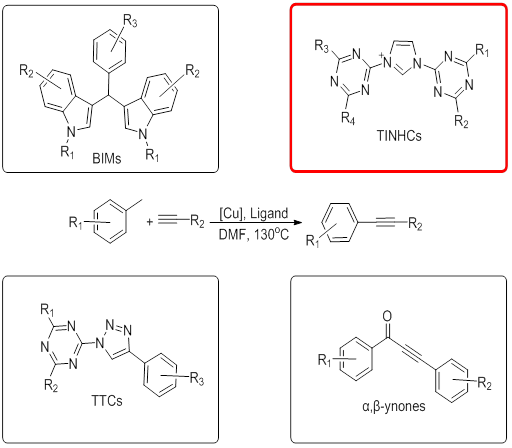
Zhongyi Ma
Chinese Academy of Sciences, China
Title: Comparative study of CO adsorption on zirconia polymorphs by diffuse reflectance FT-IR and transmission FT-IR spectroscopy
Time : 17:20-17:45

Biography:
Zhongyi Ma is an associate professor at Institute of Coal Chemistry, Chinese Academy of Science. He got his Bachelor degree at Qufu Normal University in 2000 and his PhD at Institute of Coal Chemistry, Chinese Academy of Science in 2005. He has 10 years of industrial experience in the petrochemical industry. He worked as Postdoctoral at South Dakota State University during 2011-2012. He is working as Associate Professor in Institute of Coal Chemistry. His research fields include Fischer-Tropsch synthesis, biomass conversion.
Abstract:
Interests in the surface properties of zirconia aroused a steady interest over many years because this solid exhibited catalytic behavior in dehydration, hydrogenation, and hydrogen exchange reactions. A great deal of work has been devoted to the study of zirconia, as both a catalyst and a support for metal catalysts. In this study the interactions of CO with amorphous zirconia (am-ZrO2), monoclinic zirconia (ZrO2), and tetragonal zirconia (t-ZrO2) were investigated by diffuse reflectance FT-IR spectroscopy and transmission FT-IR to determine the influence of zirconia polymorphs on CO adsorption and conversion. Moreover, the effects of dehydroxylation degree of different zirconia polymorphs on CO adsorption at ambient temperature was also surveyed at different thermal vacuum treatments were observed by transmission FT-IR. The results showed that zirconia polymorphs exerted a great influence on CO adsorption, the formation and conversion of surface intermediates, and the active sites for CO adsorption varied with the dehydroxylation degree of zirconia polymorphs. CO bands were detected on am-ZrO2 and m-ZrO2 samples either by CO adsorption at high temperature or CO adsorbed on dehydroxylated samples. The former was achieved by formation of formate species at high temperature via CO reacting with surface hydroxyl. The latter achievement was accomplished by the thermal dehydroxylation to decrease the surface coordinative water and hydroxyl. While in the case of t-ZrO2 sample, CO band was only created by the formation of bicarbonate species at high temperature to produce the cationic sites. The active sits for CO adsorption were created by CO reacting with surface hydroxyls at elevated temperature in the case of DRIFT spectra, while the active sites were produced by the thermal dehydroxylation in transmission FT-IR spectra.
A) 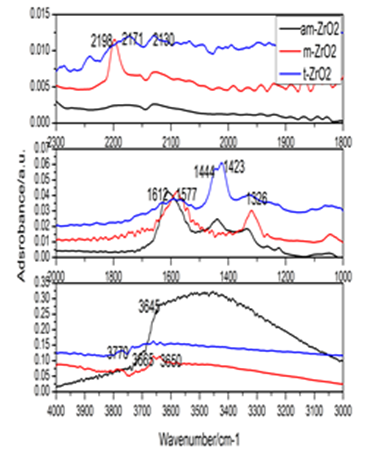
 B)
B)
Fig.1: FT-IR of CO adsorption on ZrO2 polymorphs. A: DRIFT spectra; B: Difference transmission infrared spectra
Wei Zhang
Chinese Academy of Sciences, China
Title: The synthesization of SAPO-11 and its catalytic performance for the alkylation of naphthalene
Time : 17:45-18:10

Biography:
Wei Zhang is an Associate Professor at Institute of Coal Chemistry, Chinese Academy of Science. He got his Bachelor degree at Taiyuan University of Technology in 1999 and his PhD at Institute of Coal Chemistry, Chinese Academy of Science in 2010. From 2010 till now, he has been working as Assistant Professor in Institute of Coal Chemistry. His research fields include Fischer-Tropsch synthesis, biomass conversion.
Abstract:
The SAPO-11 zeolite is a member of the silico-aluminophosphate (SAPO-n) family which was first synthesized by Union Carbide Corporation. It has novel pore structures and exhibits milder acidity due to the presence of phosphorus. The pore size of SAPO-11 was more than 0.60nm, which can sieve effectively the products of the methylation of naphthalene. In this study, SAPO-11 zeolites were successfully synthesized by using three different templates (diethylamine (DEA), di-n-propylamine (DPA) and di-iso-propylamine (DIPA)) under hydrothermal conditions. The structures and acidities of SAPO-11 were characterized by means of XRD, BET and NH3-TPD. XRD results indicated that the directing effect of different templates for AEL structure decreased in the order of DPA >DEA>DIPA. N2 adsorption-desorption results showed that SAPO-11(DPA, 1.2) possesses higher surface area and larger pore volume than other samples, which corresponds to the higher crystallinity. This is in agreement with the results of the XRD.
The alkylation of naphthalene (NAPH) with methanol (ME) on the SAPO-11 zeolite was investigated. 1, 3, 5-trimethylbenzene (TMB) was used as solvent. The effects of the reactant mol ratio, the reaction temperature and the weight hourly space velocity (WHSV) on the conversion of NAPH and the selectivity to 2, 6-dimethylnaphthalene (2, 6-DMN) was studied. The results showed that the optimum reaction conditions are as follows: 0.1 MPa, 425℃, n(NAPH)∶n(ME)∶n(TMB)=1∶5∶3.5, WHSV 0.06 h−1.
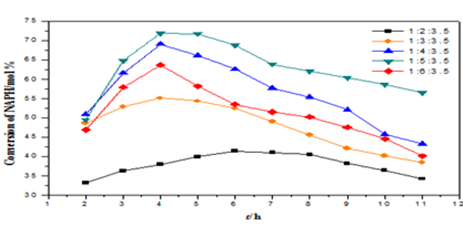

Fig.1: The effect of reactant mol ratio on the conversion of NAPH and the selectivity to 2, 6-DMN
Abdolreza Hajipour
Isfahan University of Technology, Iran
Title: Co nanoparticles as efficient catalysis in homo- and hetero coupling reaction
Time : 18:10-18:35

Biography:
Abstract:
In recent years, among the first-row transition metal catalysts, cobalt catalyst has attracted much attention in organic synthesis because it is readily available, non-toxic, low-cost, and stable in air and exhibits high catalytic activity. However, to the best of our knowledge aryl halide–heteroatom cross-couplings using cobalt salts are rare, catalyst application of cobalt salts combined with ligands have explored as a suitable catalyst for construction of C–N and C–O bonds via dehalogenative paths. In a continuation of our recent investigations in developing efficient catalysis and their application in organic synthesis, herein, we would like to report new green and economical methods for the synthesis of organic compounds using cobalt nanoparticles (Co-NP) as green, efficient and non-toxic catalyst.
Wen-Yong Lai
Nanjing University of Posts and Telecommunications, China
Title: π-extended star-shaped polycyclic aromatic hydrocarbons: Synthesis, self-assembly and facile-tunable emissive properties

Biography:
Wen Yong Lai is a Full Professor at the Nanjing University of Posts and Telecommunications. He received his PhD from Fudan University in 2007. He then joined the Key Laboratory for Organic Electronics & Information Displays and Institute of Advanced Materials, Nanjing University of Posts & Telecommunications. His research mainly focuses on the design, synthesis and application of organic and polymer optoelectronic materials for organic/plastic electronics. He is also interested in the exploration of novel materials and processes for printed electronics.
Abstract:
A novel set of star-shaped polycyclic aromatic hydrocarbons (PAHs) based on naphthalene-fused truxenes, named as TrNaCn (n=1-4), were synthesized and characterized. Oxidative cyclodehydrogenation was carried out following the microwave-assisted six-fold Suzuki coupling reaction. It is worthwhile to mention that multiple dehydrocyclization samples can be isolated effectively in one reaction, suggesting that the oxidative cyclodehydrogenation was a stepwise ring-closed process. Thermal, optical, and electrochemical properties, and self-assembly behaviors of the resulting oxidized samples were investigated to understand the impact of the ring-fused process on the properties of star-shaped PAHs. Distinct bathochromic shift of the absorption maxima λmax reveals that the molecular conjugation extends with the stepwise ring closed reaction. The optical band gap energy of these PAHs varied significantly with increasing the fused rings, resulting in facile-tunable emissive properties for the resultant star-shaped PAHs. Interestingly, with the generation of perylene analogue rigid arms, TrNaC2 and TrNaC3 showed significant enhancement of photoluminescence quantum yields (PLQYs) in solution (η=0.65 and 0.66, respectively) in comparison with those of TrNa and TrNaC1 (η=0.08 and 0.16, respectively). With strong intermolecular interactions, the precursor TrNa is found to be able to self-assemble into rod-like microcrystals which can be facilely identified by naked eyes, while TrNaC1 self-assembles into nanosheets once the naphthalene rings are fused. This study offers a unique platform to gain further insights and better understanding into the photophysical and self-assembly properties of π-extended star-shaped PAHs.
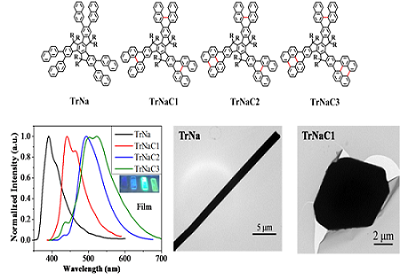

Biography:
Akhilesh Kumar Verma obtained his PhD degree in 2000 from the Department of Chemistry, University of Delhi, India. He was a postdoctoral Fellow with Professor Alan R Katritzky at the University of Florida, Gainesville, USA, from 2001 to 2002, and with Prof. Richard C Larock at Iowa State University of Science and Technology, Ames, Iowa, USA, from June 28, 2007 to August 31, 2008. He started his career as a Lecturer in 1998 at the Dr. B R Ambedkar Center for Biomedical Research at the University of Delhi, India. He joined the Department of Chemistry University of Delhi in January 2009 as a Reader. He was appointed as Associate professor in 2010 and since 2013 he is Full Professor in the department. His research interests include developing new synthetic methodologies; heterocyclic synthesis using alkynes and designing of benzotriazole based novel ligands for copper and palladium-catalyzed coupling reactions.
Abstract:
Synthesis of small heterocyclic molecules in terms of selectivity, operational simplicity, functional group tolerance and environmental sustainability are in constant demand as majority of drugs; drug-like compounds contain hetero atom at their core. In continuation of our interest in the synthesis of heterocycles using alkynes, we have successfully engineered the synthesis of variety of biologically important heterocyclic scaffolds using electrophilic cyclization/hydroamination/and alkyne annulations. In this presentation the author would like to discuss about recent results in this chemistry.
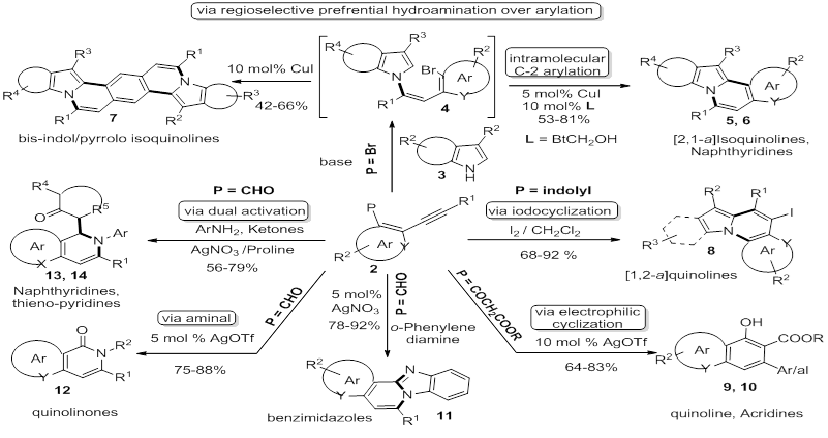
Isaiah Ramaite
University of Venda, South Africa
Title: Isolation, characterization and biological evaluation of Terminalia serecia metabolites

Biography:
Isaiah DI Ramaite has done his PhD in Physical Organic Chemistry from Rhodes University. He has been lecturing at higher education for the past 20 years. His main research interest is organic synthetic chemistry of heterocyclic compounds and also natural products chemistry of plants that are currently being used by traditional healers in Limpopo Province, South Africa. He is also interested in chemical education for both high school learners and undergraduate university students.
Abstract:
The Limpopo province has a rich biodiversity of a wide range of plants which are currently being exploited by traditional healers for the treatment of various diseases. As part of an ongoing research programme in natural products at the University of Venda, we have been interested on Terminalia sericea Burch ex. DC. Ethno medicinal information revealed that the fruit, leaves, stem bark and roots of T. sericea are commonly used for the treatment of coughs, skin infections, diabetes, diarrhea, and gonorrhea. Anolignan B and termilignan B isolated from the root have been reported to possess antibacterial activity against Bacillus subtilis, Staphylococcus aureus, Escherichia coli and Klebsiella pneumoniae. The aim of our study was to isolate, purify and evaluate the biological activity of various fractions and pure compounds. Various spectroscopic techniques such as 1D and 2D, HRMS and IR were used to elucidate the structures of pure compounds. This study has shown that the antibacterial constituents of T. sericea root cannot be limited to compounds with lignan structure which have been isolated previously from fractions obtained from mixture of hexane and ethyl acetate using silica gel. The presentation will focus on the results of antibacterial activity against diarrhea pathogens and skin infection organism, and isolated compounds responsible for these activities including their structural elucidation
Pallavi Mangesh Patil
P E Society’s Modern College of Pharmacy, India
Title: Stability-indicating HPTLC method for simultaneous determination of ketoprofen, methyl paraben and propyl paraben in gel formulation

Biography:
Abstract:
Aim: A novel and quick HPTLC-densitometry method was developed for the simultaneous determination of ketoprofen, methyl paraben and propyl paraben.
Methods: Chromatographic separation of the drugs was performed on precoated silica gel 60F254 Merck plates using toluene: ethyl acetate: glacial acetic acid (6.5:2.5:1.0 v/v/v) as a mobile phase. A TLC scanner set at 265 nm was used of ketoprofen, methyl paraben, propyl paraben respectively were validated according to ICH guidelines. Forced degradation conditions of hydrolysis (neutral, acidic and alkaline), oxidation, photolysis and thermal stress as suggested in the ICH guideline Q1A (R2).
Results: The three drugs were satisfactorily resolved with Rf values of 0.33_0.05, 0.54_ 0.05, 0.71_0.05 for ketoprofen, methyl paraben, and propyl paraben respectively. Calibration curves were polynomial in the range 200e1000 ng/band, 200e1500 ng/band, 100-600 ng/band, for Ketoprofen, Methyl Paraben, and Propyl Paraben respectively. Correlation coefficient (r) values were 0.9917, 0.9927, 0.9906 Ketoprofen, Methyl Paraben, Propyl Paraben respectively. The percentage recovery ranges from 99% to 101%.
Conclusion: A low relative standard deviation (<2%) was found for both precision and robustness study showing that the proposed method was precise and robust. The method had an accuracy of 99.95%, 99.85% and 100.07 of ketoprofen, methyl paraben, propyl paraben respectively were validated according to ICH guidelines. The drug showed instability in oxide, heat and UV light, while it remained stable in neutral conditions.
Adeyemi Olufemi
Olabisi Onabanjo University, Nigeria
Title: Biosorption of cadmium and lead ions from aqueous solution of cashew (Anacardium occidentale) leaf

Biography:
Abstract:
The potential of using cashew (Anarcardium occidentale) leaf to remove Pb (II) and Cd (II) ions from aqueous solution was investigated. The influence of pH, contact time and initial metal ion concentration and temperature were studied using batch experiment. The biosorption of the metal ions was found to be pH dependent. Analysis of the FT-IR spectra showed the presence of ionizable functional groups (C=O, O-H) which were able to interact with cations and thus served as the active sites for the removal of positively charged Pb (II) and Cd (II) ions from solution. Thermodynamic parameters such as the free energy change (ΔG), ΔH and ΔS were evaluated it was found that the sorption process was feasible, spontaneous and endothermic.
Yinghuai Zhu
Agency for Science, Technology and Research (A*STAR), Singapore
Title: Advanced developments in boron neutron capture and therapy (BNCT) and related nano catalysis

Biography:
Abstract:
Boron neutron capture therapy (BNCT) continues attracting wide interesting due to its high performance in cancer treatment and significant progress in neutron beam study. We have developed the low toxic and high efficient BNCT agents, which demonstrated high selectivity of tumor to normal tissues. In this presentation, we deliver the recent progresses in BNCT research and nano catalysis technology that is exceedingly useful in boron chemistry.
